
4.9★ on G2 reviews

4.7★ on Capterra reviews
Explore fresh, expert perspectives on customer engagement and innovation
Stay at the forefront of customer engagement, contact centre innovation, and AI-powered communication.
discover the latest
articles and insights

Boosting Your Contact Centre Sales Performance: 2024 UK Benchmarking Insights
Contact centre leaders who work in outbound sales teams face the constant challenge of driving revenue growth while maintaining high levels of customer satisfaction. Our recent survey, conducted in May 2024, gained insights from 167 UK contact centre leaders who work in outbound sales teams, with sizes ranging from 20 to 4,999 agents. The results of the survey provide valuable insights into the current state of sales performance metrics. In this blog, we’ll explore the key findings and offer practical advice on how to improve your outbound sales team’s performance in four critical areas.
Average Daily Calls per Agent
Our survey revealed that the mean number of daily calls per agent is 56.55, with 50% of sales teams handling between 31-60 calls per agent per day. To optimise your team’s performance, it’s crucial to find the right balance between quantity and quality of calls. Encourage your agents to focus on having meaningful conversations with prospects rather than rushing through calls to meet quotas.
Consider implementing a call scoring system that takes into account both the number of calls and the quality of the interactions. Provide regular coaching and feedback to help agents improve their time management and conversation skills. Invest in technology solutions that streamline the calling process and reduce idle time between calls.
Success per Call Rate
The mean success per call rate among those surveyed is 6.74%, with 26.35% of teams achieving a 4-5% success rate. To improve your team’s success rate, focus on providing comprehensive product training and sales techniques. Equip your agents with the knowledge and skills they need to effectively communicate the value of your offerings and overcome objections.
Analyse successful calls to identify best practices and share them with your team. Encourage agents to personalise their approach based on the prospect’s needs and preferences. Implement a lead scoring system to prioritise high-quality leads and increase the likelihood of success on each call.
First-Call Close Rate
The survey found that the mean first-call close rate is 27.81%, with 29.94% of teams achieving a 20-29% close rate. Closing sales on the first call is essential for maximising revenue and efficiency. Train your agents to identify buying signals and confidently ask for the sale when the time is right.
Provide agents with a clear sales process and scripts that guide them through each stage of the call. Offer incentives and recognition for agents who consistently achieve high first-call close rates. Analyse unsuccessful first calls to identify common objections and develop strategies to overcome them.
Average Revenue per Call
The mean average revenue per call among surveyed teams is £197.60, with 24.55% of teams generating between £30-£59 per call. To increase your average revenue per call, focus on upselling and cross-selling techniques. Train your agents to identify opportunities to offer complementary products or services that enhance the value for the customer.
Implement a tiered pricing structure that encourages customers to purchase higher-value packages. Offer limited-time promotions or bundled deals to create a sense of urgency and increase revenue per call. Regularly review your product offerings and pricing to ensure they remain competitive and attractive to your target audience.
Data-Driven Decisions in your Contact Centre
By understanding these industry benchmarks and implementing best practices, sales leaders in contact centres can drive significant improvements in their team’s performance. Use these insights to set ambitious yet attainable goals, prioritise training and development initiatives, and make data-driven decisions to optimise your sales strategy.
Remember, success in sales requires a combination of skilled agents, effective processes, and a customer-centric approach. By continuously monitoring your team’s performance and adapting to changing customer needs and market conditions, you can position your contact centre sales team for long-term success and growth.

Ben Booth named one of the UK’s Top 50 Most Ambitious Business Leaders for 2024
Ben Booth, CEO of MaxContact has been recognised as one of The LDC Top 50 Most Ambitious Business Leaders for 2024, in partnership with The Times.
Created by trusted investment partner LDC – part of Lloyds Banking Group, The Top 50 celebrates entrepreneurs demonstrating remarkable ambition, and is now in its seventh year.
This year the programme received more than 700 nominations showcasing the exceptional individuals building successful and growing businesses right across the UK.
The business leaders featured in The LDC Top 50 for 2024 are making a real impact by creating jobs, promoting social equality, championing sustainability, expanding internationally and integrating purpose into their business practices. They operate from 39 towns and cities across the UK and span every sector of the economy, collectively they employ 5,146 people and generate revenues of more than £1.1bn.
MaxContact is the best cloud contact centre platform for delivering conversation outcomes and customer insights to generate more revenue – compliantly. After ten years working for a contact centre solution reseller, CEO Ben Booth was frustrated with providers that overpromised and underdelivered on features, support and resilience. Determined to enhance the agent and customer experience, MaxContact was formed. Over 7 years later, the business has become one of the fastest growing contact centre technology specialists in the UK.
Ben Booth, CEO of MaxContact said: “Being recognised as one of the UK’s Top 50 Most Ambitious Business Leaders is a testament to the incredible work the team at MaxContact has accomplished. We started this journey with a vision to transform the contact centre industry, focusing on delivering exceptional customer experiences and driving revenue growth for contact centres, globally. This accolade reinforces our commitment to innovation and excellence in the field. As we continue to grow and evolve, we remain dedicated to our mission of enhancing both agent and customer experiences in the contact centre space.”
John Garner, Managing Partner at LDC, added: “It’s been seven years since we launched The LDC Top 50 and in that time we’ve had the privilege of meeting some truly remarkable people. Our business leaders for 2024 show relentless drive and determination in their growth ambitions, and I’d like to congratulate them on everything they’ve achieved so far. This is certainly not the end of their success and we can’t wait to see what the future holds.”
Read more about The LDC Top 50 Most Ambitious Business Leaders for 2024 here: https://bit.ly/3Y3rfxY

AI in contact centres: optimising employee and customer experience

A leaders guide to moving to a cloud call dialler solution
After the events of the last few years, contact centre and IT leaders are looking at their contact centre technology and asking if it could be improved. The shift from onsite to more remote and hybrid working arrangements emphasised the advantages of cloud-based solutions in all sorts of areas, and contact centre software was no exception.
Cloud vs. on-premise contact centre software
You probably know the script by now. Cloud-based software allowed agents to swiftly and smoothly transition to remote working almost overnight. It gave them all the features they had on their office handsets, only anywhere and on any device. It allowed managers to monitor productivity remotely.
In a nutshell, cloud was just a lot easier in a crisis than on-premise solutions.
And yet, some contact centre/IT leaders still doubt moving outbound operations to the cloud. That’s understandable. Handing control over crucial infrastructure to a third party is a leap of faith. When sensitive data and painstakingly nurtured customer relationships are at stake, it’s natural to be cautious.
Take a look at the table below for a snapshot of some of the other key differences between on-premise and cloud solutions.
We’ve discussed harnessing the benefits of cloud contact centre software more in-depth in another blog. However, in the rest of this guide, we will be looking at cloud diallers from a contact centre leader’s perspective with four objections we hear every day,explaining how the latest cloud software overcomes them
Overcoming objections to cloud-based dialler
Objection 1: “We won’t be in a crisis forever”
Thankfully, the pandemic is over but life hasn’t exactly gone back to normal. Many companies are still offering flexible, work-from-home call centre agent roles.
So why struggle on with inflexible on-premise software? It’s widely accepted that cloud dialler software make it easier to equip remote workers.. Companies that continue to offer hybrid working as standard (when working time is split between home and office) will have a recruitment and retention advantage.
Quite simply, the best agents will favour businesses that give them more flexibility over where and when they work. Cloud dialler software makes that easier because your team can work from anywhere, without compromising functionality or quality.
Objection 2: “We can’t afford ongoing cloud fees”
Many leaders and Financial Directors like the one-off fee of traditional contact centre solutions. You buy it, and you own it. Whereas a cloud dialler license is essentially a rental agreement that has to be renewed every month.
But does that make cloud dialler software more expensive? No. Here’s three reasons why:
- There are no upfront costs beyond handsets (or you can use softphones or BYOD for free) and no ongoing maintenance fees.
- Updating and upgrading is handled remotely by your provider, freeing up IT staff time for more productive tasks. You don’t have the hardware refresh cycle of buying new hardware typically every 3-5 years.
- Plus, you never pay for capacity you can’t use.
Get built-in security, high-availability and infinite scalability with cloud-based solutions.
This last point is important. With a cloud dialler, you can scale up your requirements with a couple of clicks. You can scale down again just as easily. You never have to invest in spare capacity ‘just in case’.
It’s the same with features and functionality. When you buy a desktop software solution, it’s essentially static. When a new upgraded version comes out, you have to invest all over again.
With cloud, your license fee covers updates, upgrades and new functionality – you get built-in security, high-availability and infinite scalability.
At MaxContact, we drive a continual cycle of innovation, and new features are pushed out to customers automatically (you can choose whether you want to use them or not).
We could go on, but suffice to say, that when you take all this together, cloud is both more agile and more cost-effective than on-premise equivalents.
Objection 3: “We love the contact centre features we have”
We get it. Your current set-up comes with a host of productivity-enhancing features and a predictive dialler that means your agents spend more time talking to customers and less time on unanswered calls. It’s a lot to give up.
Well, it would be if cloud-based alternatives couldn’t do better.
As we mentioned above, the beauty of cloud is that it allows for continual innovation, and that includes regular data-driven tweaks to performance algorithms. In our case, that’s made for a predictive dialler which performs far better than industry standards.
Let’s put it this way. Most diallers (on-premise and cloud) advertise a 300% uplift over manual dial. We set the bar higher, aiming for that level of uplift not just over manual dial but over other diallers too. Our outbound solution also manages itself over the course of a day, automatically optimising performance while you get on with other tasks.
With cloud, you don’t just get all the normal dialler features. You get new features as soon as they’re available.
With SaaS, customers benefit from 10 times more updates in a year than onsite dialling solutions – which normally offer an upgrade every six months.
And of course, you get full compliance, which in MaxContact’s case also means built-in proprietary features that reduce the chance of dropped calls.
We get it. Your current set-up comes with a host of productivity-enhancing features and a predictive dialler that means your agents spend ore updates in a year than onsite dialling solutions – which normally offer an upgrade every six months.
And of course, you get full compliance, which in MaxContact’s case also means built-in proprietary features that reduce the chance of dropped calls.
Objection 4: “Cloud is a security risk”
All SaaS creators have faced this objection at one time or another, and it’s probably the biggest leap of faith contact centre managers have to make. You’re dealing with sensitive data. Any breach could threaten your reputation, your revenue and your future, so you’re right to be wary.
But in 2023, the best way to protect your data is in the cloud. Don’t just take our word for it. In the most recent KPMG/Oracle Cloud Threat Report, three-quarters of IT and cybersecurity professionals felt the cloud was more secure than their own data centre.
How does security pan out with cloud contact centre solutions? Well, our services are hosted on the Microsoft Azure public cloud, which is backed by Microsoft’s huge security investment and the latest global security standards. By working with Azure, our solution is automatically protected by regular intrusion detection monitoring, penetration testing and virus scanning.
Security is also at the core of our software development. We rigorously test everything ourselves, and then we employ third-party experts to test everything again – and again. The upshot is a highly secure solution on a highly secure network.
Learn about our built-in security & compliance >
Ready to adopt a cloud-based dialler solution?
We’ve covered four objections we hear every day about migrating to a cloud-based solution including the changing work environment, fees, feeling comfortable with your existing features, and security and compliance. It is clear that the latest cloud software overcomes all of these and allows contact centre managers to enjoy efficiency, productivity, enhanced security and cost benefits.
Want to find out more about moving to a cloud-based solution in your contact centre? Book a demo today.

Outbound Dialler Features You Need In Your Call Centre
Whether you’re looking to supercharge sales, streamline debt collection, or elevate customer service, the right outbound dialler can redefine how you connect and communicate. So, continue reading to learn more about automated diallers and discover the potential they hold for your contact centre’s success
So, what’s an outbound dialler?
Put simply, outbound dialling is the process of making calls to customers or contacts, typically for sales or marketing purposes.
While outbound dialling can be performed manually on a mobile or business phone, this is not practical when dealing with a high volume of calls. A range of additional features can enhance outbound calling in a contact centre setting through the use of an automated dialler.
What does an outbound dialler do?
An outbound dialler is generally a cloud or software solution that automatically dials phone numbers and makes calls on behalf of your sales, collection or customer service teams. As such, it’s an essential ingredient in any organisation where you need to make outbound calls to clients and prospects throughout the day.
What are the different types of call centre diallers?
The main options are a manual dialler and an auto dialler.
Manual Dialler
A manual dialler is like a traditional phone. A call agent manually dials numbers from a call list, one after another.
Auto Dialler
As the name suggests, an auto dialler automates much of the dialling process. It digitally dials numbers, and can also dial multiple numbers at once, passing answered calls to available agents.
Manual vs Auto Dialler
Why would you choose one over another? Most call centres now opt for auto dialling, because it significantly boosts productivity. Agents spend more time talking to customers and less time dialling unresponsive numbers.
Manual dialling can still be useful, but only for campaigns involving a small number of high value customers who demand a more personal approach.
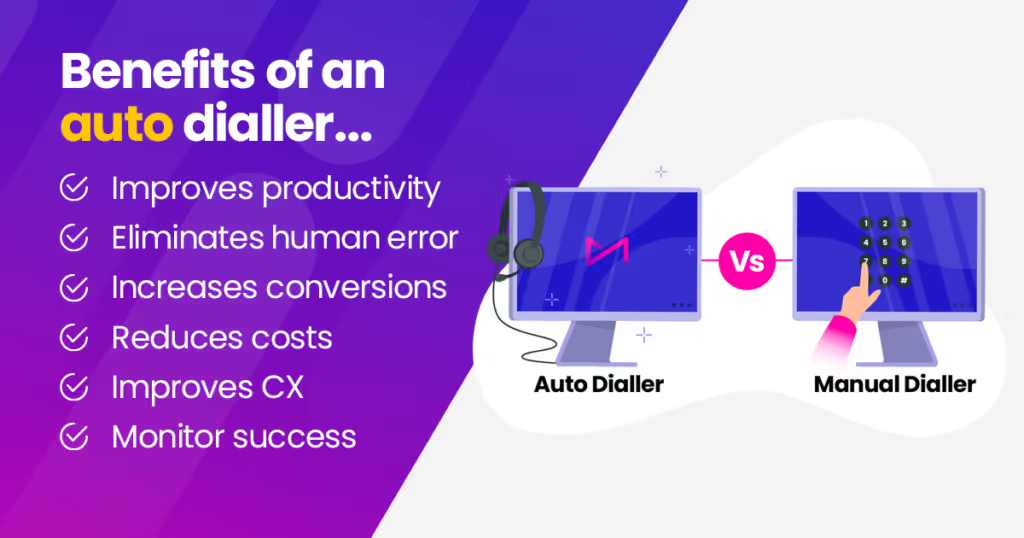
The different outbound dialler modes
If you’re using an auto-dialler, there are likely three dialler modes that you’ll frequently use, depending on the type of outbound calling you are doing. These are predictive diallers, progressive diallers and preview diallers.

Predictive dialling
What is it? When most people think of outbound dialling software, they tend to think of predictive dialling. Predictive dialling places calls based on the software’s predictions of agent availability. It dials multiple numbers simultaneously, so that when agents finish one call they can be instantly connected to the next.
What are the benefits? The best predictive diallers minimise abandoned calls (and the amount of time customers spend on hold) and maximise the time your agents spend having conversations. When should I use it? Predictive dialling is the standard for straightforward, high volume sales campaigns (like commodity sales) or debt collection activity.
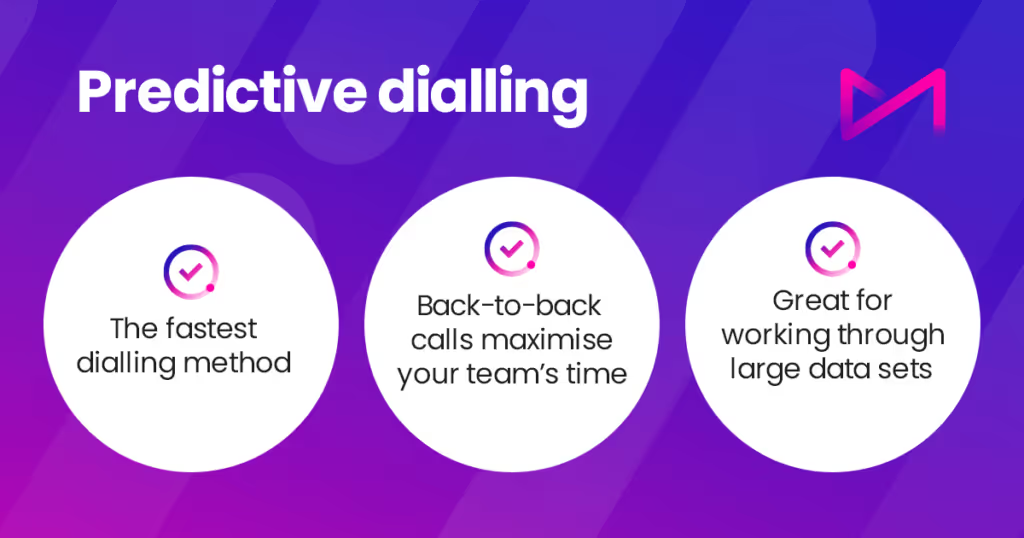
Progressive dialler
What is it? Progressive diallers are predictive diallers that slow the pace down by only dialling a number when an agent is available to take the call. Dialling is instant and automatic, so the system still allows for a relatively high number of calls.
What are the benefits? Progressive dialling eliminates the risk of customers abandoning calls or waiting a frustratingly long time before being connected to an agent. Because an agent is always available, the customers you have painstakingly nurtured over a period of time feel valued and importan
When should I use it? It is often used in campaigns that target current customers. It’s a low risk option that can improve customer experience and effectively help agents upsell additional products and services.
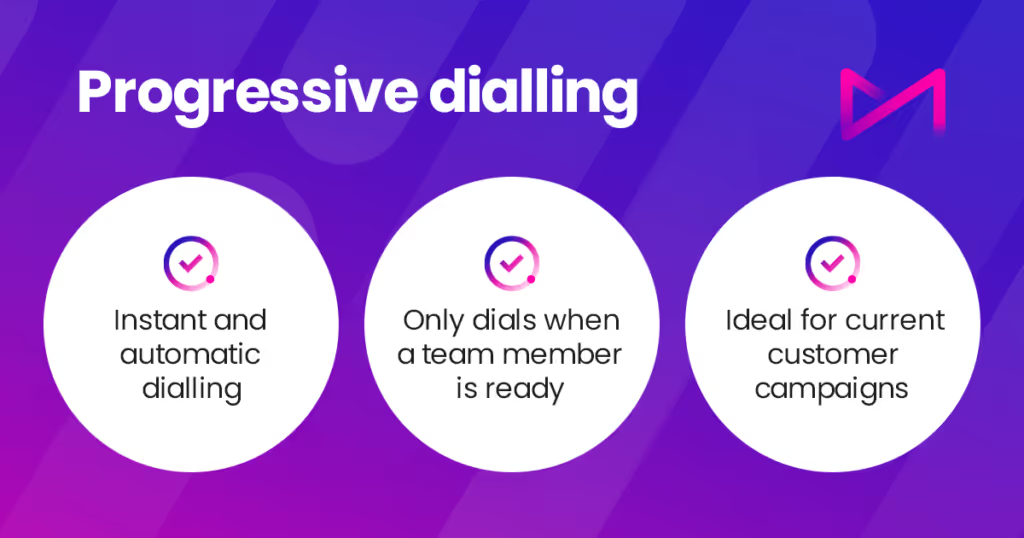
Preview dialler
What is it? A preview dialler takes the pace down another notch. When an agent indicates availability, information about the next call is sent to the agent for preview.
After a set amount of time – say, one minute – the number is automatically dialled. This delay lets the agent prepare for the call, using information typically taken from the company CRM system – which are often integrated into the dialler.
What are the benefits? Agents can have more in-depth, focused conversations, based on a customer’s real experiences and challenges. It can improve customer experience and increase the number of positive outcomes.
When should I use it? Preview diallers are particularly helpful when the reason for the call is complex or sensitive. For example, following up with web leads or dealing with customer complaint calls.
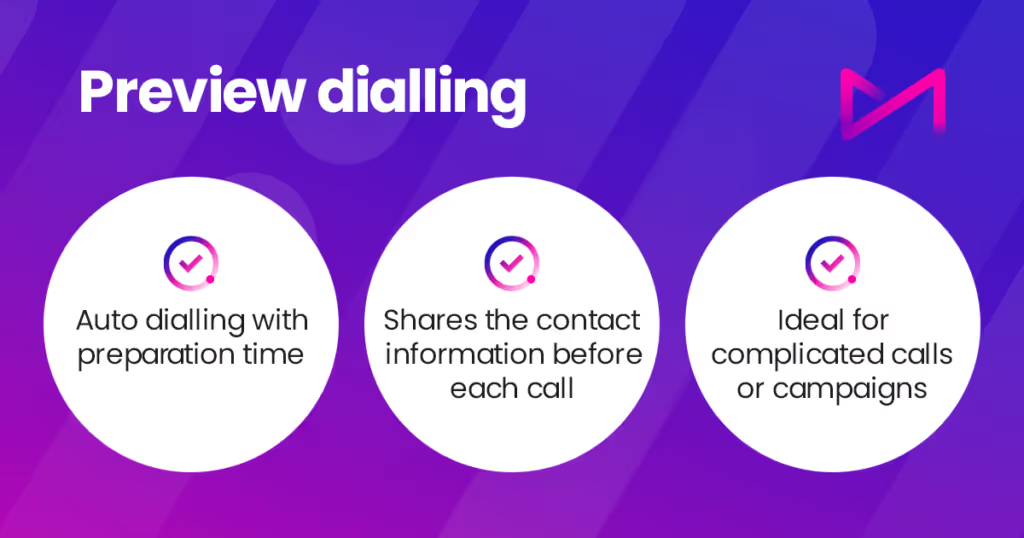
Explore the three dialler modes in more detail >
How are automated diallers used?
Outbound diallers can be integrated into many industries. Any company with an outbound contact centre who are cold calling or making high volume phone calls can benefit from outbound dialler software.
Power up your sales teams
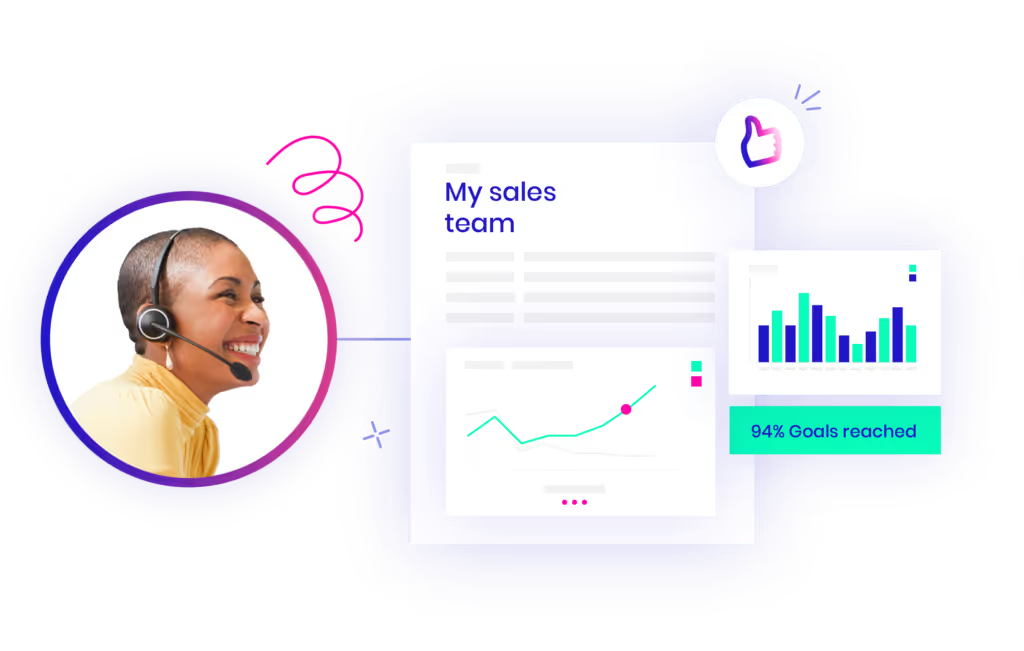
Sales campaigns are often high volume and low touch. Predictive dialling is the gold standard for straightforward, high volume outbound campaigns (like commodity sales). It can quickly and efficiently work through large datasets, making sure leads are contacted while they’re still warm.
The best predictive diallers minimise abandoned calls (and the amount of time customers spend on hold) and maximise the time your agents spend having conversations. They can be set to play messages if they meet an answerphone, and will recycle numbers (placing unanswered calls back into the call queue) in a way that ensures your customers or leads are contacted, but never pestered.
The right outbound dialler can make selling straightforward by helping to connect your sales people to the right customers at the right time. Combined with the contact centre-specific features mentioned earlier, it can offer powerful tools for contacting customers, winning business and exceeding customer expectations.
Increase debt collection rates
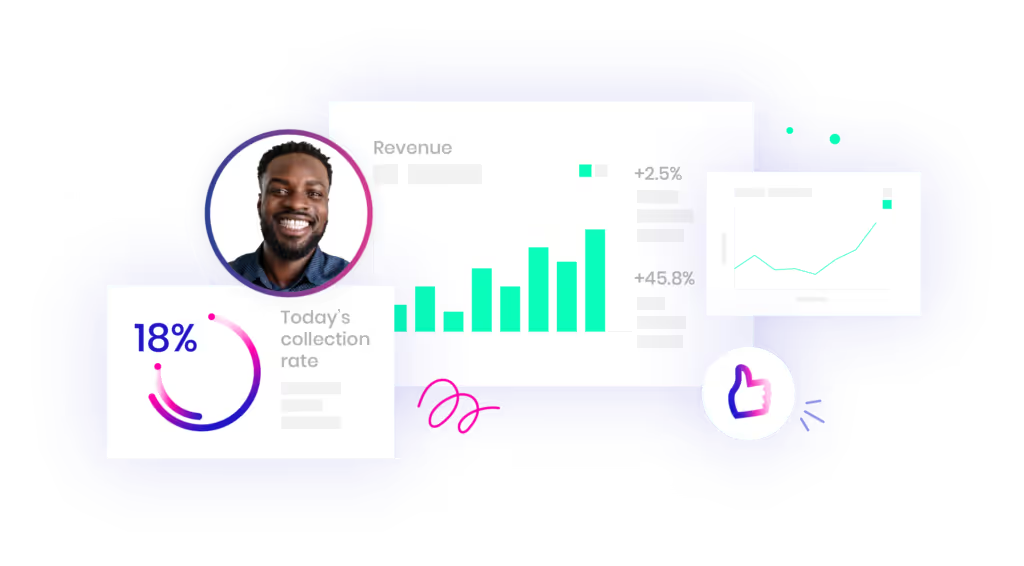
Your credit and debt resolution teams can use effective targeting to reach priority customers at times that suit them. Maximise collection rates using advanced data segmentation and encourage self-serve with automated communications. Automate payments with self-serve options providing customers choice and improving satisfaction.
Preview diallers are particularly helpful when the reason for the call is complex or sensitive. For example, debt collection calls are more likely to end positively if agents have the time to gather all the information they need beforehand.
Elevate your customer service teams
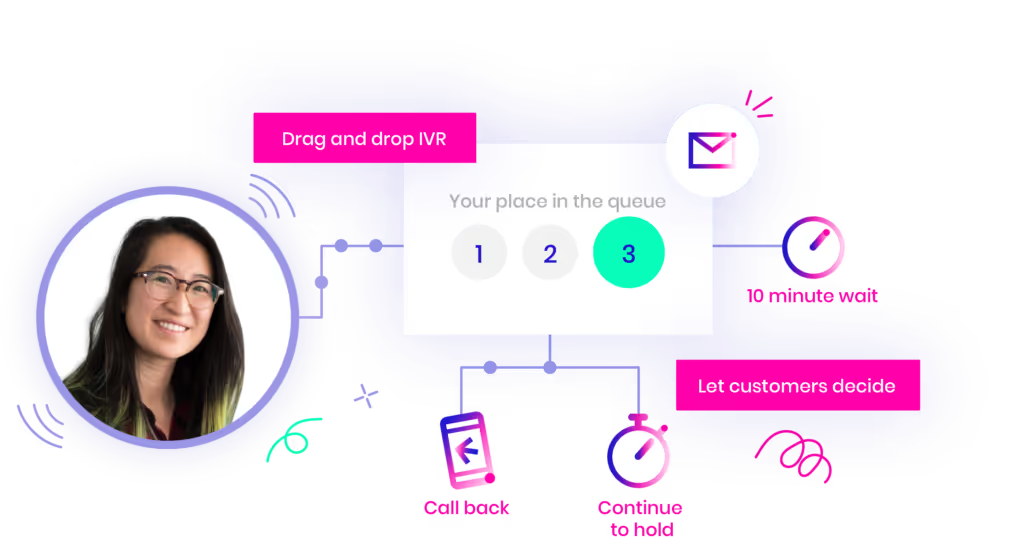
Customer service teams often use progressive dialling to target current customers with after sales information or courtesy communications. It’s a low risk option that can improve customer experience, help nurture loyalty and effectively help agents upsell additional products and services. Because an agent is always available to have a conversation, the customers you have painstakingly nurtured over a period of time feel valued.
5 must-have outbound dialler features
Answer Machine Detection (AMD)
Answer Machine Detection (AMD) lets your auto-dialler software identify answering machines before connecting calls to agents. This means agents only spend time on live conversations, saving them valuable time and boosting productivity.
AMD is particularly helpful for high-volume sales campaigns where every minute counts. MaxContact’s AMD boasts a 90% success rate in detecting answering machines, freeing up agents to focus on reaching real people.
Speech analytics
Forget manually reviewing call recordings! Speech analytics uses AI to analyse every conversation, automatically identifying customer sentiment, call quality, and agent performance. This lets you:
- Spot frustrated or vulnerable customers who need extra care.
- Ensure agents follow compliance guidelines.
- Understand what customers are saying about your products and competitors.
Speech analytics gives you valuable insights from all calls, not just a select few. It saves time and helps you improve the overall performance of your contact centre.
A secure payment manager
A secure payment IVR gives customers the payment options they want, while giving teams the time they need to deal with more complex or sensitive cases.
Payment automation helps you speed up debt collection and improve cash flow. When you give customers more convenient ways to pay, they’re more likely to stick to payment schedules.
MaxContact’s payment IVR is fully PCI compliant, protecting customer information at all times. We offer both assisted payments, in which staff safely guide customers through the payment process, and automated payments, which are fully self-serve and available 24/7.
Analytics and reporting
You can only improve contact centre performance when you can measure it. When you’ve done that, you need to present the data in a way that is easy to understand and act on. That’s where analytics and reporting come in.
MaxContact’s pre-configured reporting gives you complete visibility around productivity, issue resolution rates, revenue and customer satisfaction, to name just a few. You can set targets for campaigns, channels, teams and agents and track performance over time.
All teams – sales, service and debt resolution – benefit from better information. Pre-configured reports give you the data you need in the quickest and most hassle-free way.
Easy integration
A powerful dialler is even better when it works hand in hand with your existing systems. Imagine a sales agent having instant access to customer history, preferred contact methods, and past feedback – all within the dialler interface (thanks to CRM integration).
This allows for personalised conversations that address specific needs, leading to happier customers and improved outcomes. Easy integration applies to after-sales and debt resolution teams too. By connecting your dialler with other systems, you can put all relevant information at agents’ fingertips, reducing hold times and boosting overall efficiency.
The benefits of auto-dialler software you can’t ignore
Improve contact centre metrics like AHT
Average Handling Time (AHT) is a calculation based on the time agents spend talking to a customer, the amount of time callers are on hold and the time taken on follow up tasks, divided by the number of calls handled. The lower your AHT, the better. It means you can handle more calls, improve efficiency and reduce costs. A good dialler can improve AHT and a host of other contact centre metrics, by allowing agents to handle more calls, more efficiently.
Excel at sales and debt collection
Whether it’s sales or debt collection, the best results happen when good agents talk to customers. Whether it’s a high volume, low touch sales campaign, or more sensitive debt resolution calls, the right dialler means your agents spend more time in conversation with customers, and less time processing unanswered calls or connecting to answering machines.
Keep your contact centre compliant
A powerful predictive dialling algorithm speeds up and slows down depending on the conditions in your contact centre. If fewer agents are available, the dialling slows down, helping to ensure you stay within compliant boundaries for abandoned and dropped calls. Or you can switch to progressive or preview modes for more personal contacts. The dialler can also ensure that the frequency of calls to a contact never exceeds official limits.
Seamlessly integrate with your CMS
A dialler that integrates with your CMS system is a huge advantage. It means that the systems feed information to each other, so your agents always have the details of previous contacts at their fingertips. That reduces the risk of customers becoming annoyed by having to repeat information they’ve already previously given. It can also provide insights into customer satisfaction rates, preferred times and methods of communication and so on.
These companies boosted performance with auto diallers
We worked with these companies to replace ageing systems with modern cloud-based diallers – and the results are impressive.
Compare My Insurance
Compare My Insurance is one of the largest independent insurance and protection specialists in the UK. But dialler downtime, data issues and missed opportunities were hampering the business.
MaxContact’s dialler solution integrated seamlessly with the company back office systems. It has significantly increased contact rates while providing complete transparency around performance and progress.
APJ Solicitors
APJ Solicitors, a leading financial mis-selling specialist, needed to increase call volumes and boost efficiency, but its basic VOIP phone system was no longer up to the task.
MaxContact’s solution increased call volumes by 110% in the first year, and improved average agent call efficiency by 36%. Productivity has risen five fold over the company’s previous solution.
Improve your call centre performance with MaxContact
MaxContact offers the most sophisticated outbound dialler currently available. This continually improving cloud-based dialling solution gives you the flexibility to run your contact centre your way, letting you choose the right blend of productivity and compliance for your business needs. With over a 1,000 unique features, MaxContact’s outbound dialler helps meet your contact centre challenges in new and powerful ways.
Learn about how MaxContact’s auto dialler can improve your contact centre operations. Book a demo today to find out more.

7 ways to reduce costs in your BPO contact centre
Costs are rising across business sectors and it’s certainly the case that BPO contact centres are feeling the pinch too.
Salaries are rising with the cost of living, with pay rises of between 5% and 10% common in the industry. At the same time, talent is in short supply. Finding and keeping good people means providing competitive salaries alongside other employment benefits.
According to the Office for National Statistics (ONS), over a quarter of all businesses (26%) expect to raise the price of goods and services in February 2023, as a reaction to the rising costs of doing business. The escalating costs of energy (35%), raw materials (27%) and labour (23%) were the main reasons behind the hike in prices.
In the contact centre world, customer expectations are rising as more of us shop, bank and pay bills remotely. Satisfying that demand requires a skilled workforce with access to the right technology. Customers want to get in touch in the way that best suits them at any given time.
Or to put in another way, this isn’t the time to be cutting your workforce to the bone or abandoning your next technology refresh.
BPOs face unique challenges on top, because their portfolios often include clients with differing needs. Updating staff skills to keep them up to speed with new client requirements involves a significant investment in training and education. At the same time, hard-pressed clients are squeezing BPOs on price, and price and service flexibility have become key in securing contracts.
It feels like something of a perfect storm for BPOs, who face increasing costs and at the same time significant pressure to keep prices down. One way to meet the storm head on is to cut expenditure in your contact centre, but how do you do that without sacrificing the service levels clients demand?
Here are seven ways.
How to reduce costs in your BPO contact centre:
Turn to omnichannel contact centre software
Clients want to interact with contact centres by phone, text, email and webchat. That has forced many BPOs to invest in a separate system for each channel, piling on management and maintenance costs and complicating supplier administration.
A single omnichannel solution not only hugely reduces these costs, it also creates a more integrated, data-rich contact centre environment, improving customer satisfaction rates. One solution, one supplier, one service contact and one invoice.
An omnichannel solution creates an integrated environment that gives agents the information they need, when they need it. That negates the need for continual training on systems, and a single solution is far easier for new agents to grasp than multiple separate services. Agents also work more efficiently, increasing the productivity of your contact centre by handling multiple interactions simultaneously.
Focus on training
A well-skilled workforce handles interactions with speed and professionalism. More customer issues are solved on the first call. Errors are reduced. Ultimately, you may even be able to reduce staffing levels at certain times. Performance management programmes with feedback and coaching can also ensure your agents are working as efficiently as possible.
Better workforce management
Talking of staffing, a smart workforce management tool can make sure you always have the right balance of resources at the right time. An AI-driven system can refine staffing levels over time, meaning you’re never paying for more staff hours than you need.
Reduce call waiting times
Reducing average handling times (AHT) can lower costs because it means you can do more with less. But there’s a balance to be struck. Reducing AHT shouldn’t be allowed to come at the expense of customer experience. We explore ways to get the balance right in our blog how to reduce average handle time (AHT) while improving customer experience in your BPO contact centre.
Make automation work
Automation means getting technology to handle some of the basic, repetitive and time-sapping tasks that otherwise would be the responsibility of your agents. It can significantly reduce your workforce costs, and increase job satisfaction. That last point is important. Recruitment costs are a major brake on profitability.
One obvious automation is providing self-serve options for customers. That means basic services like payments and account checks can be carried out without contact with an agent, saving time and ultimately money.
Route calls accurately
The quicker a customer call gets to the person who can solve their problem, the better it is for everyone. Customers are happy with their experience. Agents don’t waste time rerouting calls, and the lower your cost per call. Test and refine your incoming call pathways to make sure they’re as efficient, logical and straightforward as possible.
Re-evaluate your technology
Do you have the right technology for the needs of multiple clients? Do you have an omnichannel environment in one integrated service? Can you offer self-serve secure payments, in-call agent coaching and intelligent workforce management?
If your technology is lacking or expensive, it might be time to re-evaluate your provider. This could lead to reduced maintenance and management costs, as well as lower software licensing costs.
Check out vendors that have specific experience of the challenges BPOs face. MaxContact has been working with BPO clients for over 20 years, and offers a flexible, scalable omnichannel solution with a huge range of cost-efficient features. Our powerful system easily adapts to the needs of your clients, regardless of how different they are. Learn more about finding the best contact centre solution for you here.
The takeaway here is that you’re not defenceless against rising BPO costs. By priming and refining your systems and processes, you can drive efficiency and keep costs to an acceptable level, even in this perfect storm. For more about what MaxContact can do for your BPO operation, please visit our dedicated website page.